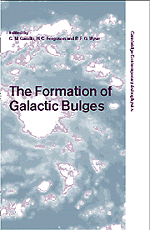Book contents
- Frontmatter
- Contents
- Preface
- Dedication: In Memory of Olin Eggen
- Part 1 Introduction
- Part 2 The Epoch of Bulge Formation
- Part 3 The Timescales of Bulge Formation
- Part 4 Physical Processes in Bulge Formation
- Part 5 Bulge Phenomenology
- Bulge-Disk Decomposition of Spiral Galaxies in the Near-Infrared
- The Triaxial Bulge of NGC 1371
- The Bulge-Disk Orthogonal Decoupling in Galaxies: NGC 4698 and NGC 4672
- The Kinematics and the Origin of the Ionized Gas in NGC 4036
- Optically Thin Thermal Plasma in the Galactic Bulge
- X-Ray Properties of Bulges
- The Host Galaxies of Radio-Loud AGN
- The Centers of Radio-Loud Early-Type Galaxies with HST
- Central UV Spikes in Two Galactic Spheroids
- Part 6 Conference Summary
- Index
The Centers of Radio-Loud Early-Type Galaxies with HST
from Part 5 - Bulge Phenomenology
Published online by Cambridge University Press: 10 November 2010
- Frontmatter
- Contents
- Preface
- Dedication: In Memory of Olin Eggen
- Part 1 Introduction
- Part 2 The Epoch of Bulge Formation
- Part 3 The Timescales of Bulge Formation
- Part 4 Physical Processes in Bulge Formation
- Part 5 Bulge Phenomenology
- Bulge-Disk Decomposition of Spiral Galaxies in the Near-Infrared
- The Triaxial Bulge of NGC 1371
- The Bulge-Disk Orthogonal Decoupling in Galaxies: NGC 4698 and NGC 4672
- The Kinematics and the Origin of the Ionized Gas in NGC 4036
- Optically Thin Thermal Plasma in the Galactic Bulge
- X-Ray Properties of Bulges
- The Host Galaxies of Radio-Loud AGN
- The Centers of Radio-Loud Early-Type Galaxies with HST
- Central UV Spikes in Two Galactic Spheroids
- Part 6 Conference Summary
- Index
Summary
We briefly discuss the properties of radio-loud spheroids, and present the first results from a HST/WFPC2 imaging survey of a sample of nearby Fanaroff-Riley-I nuclei.
Introduction: Radio Emission from Spheroids
Radio emission is observed from the centers of both active spiral bulges and E/SO galaxies. There are distinct differences in the properties of the central radio emission from these classes of galaxies (Slee et al. 1994; Sadler et al. 1995). Spirals sometimes contain compact radio cores, possibly not related to starburst activity, but a large fraction of the emission originates from an extended region of several hundred parsecs. In earlytype galaxies the emission is always completely dominated by the unresolved core. The spectral index α of the core emission (with S ∼ να for flux density S and frequency ν) is typically around –1 for spirals and around 0.3 for ellipticals. These differences appear to hold for bulges and early-type galaxies of the same luminosity. Thus, rather surprisingly, it seems that radio cores ‘know’ what kind of host they reside in.
There is also a difference in radio emission between low- and high-luminosity ellipticals. Only in high-luminosity ellipticals do we see radio-jets on the scales of hundreds of kiloparsecs, i.e., galaxies classified as FRI or FRII (Fanaroff & Riley 1974, types I and II, respectively). As noted by Sadler (1997) this threshold roughly coincides with the break which marks differences in structural properties such as stellar rotation and central cusp slope (e.g., Faber et al. 1997).
- Type
- Chapter
- Information
- The Formation of Galactic Bulges , pp. 187 - 190Publisher: Cambridge University PressPrint publication year: 2000



